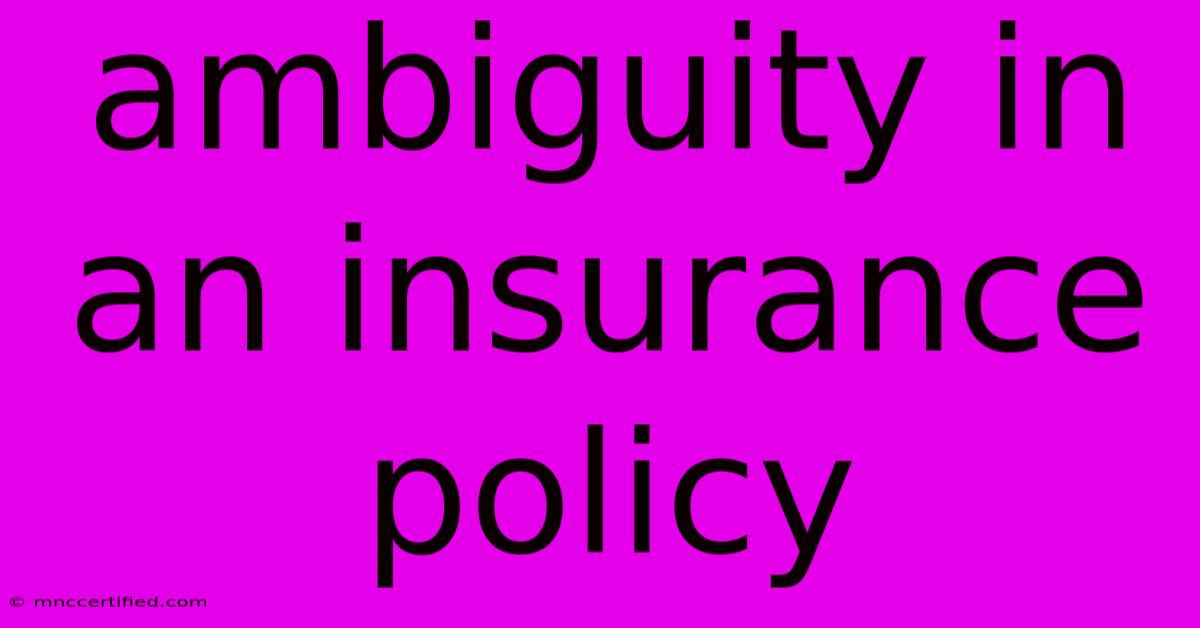Ambiguity In An Insurance Policy

Table of Contents
Ambiguity in an Insurance Policy: What You Need to Know
Insurance policies are complex legal documents designed to protect you from financial loss. However, the very language intended to provide clarity can sometimes create ambiguity, leading to disputes and costly legal battles. Understanding ambiguity in insurance policies is crucial for both policyholders and insurers. This article explores the meaning, causes, and implications of ambiguous clauses, providing valuable insights to navigate this intricate area of law.
What is Ambiguity in an Insurance Policy?
Ambiguity in an insurance policy arises when the language used is unclear, uncertain, or open to more than one reasonable interpretation. This can occur due to poorly drafted wording, outdated terminology, or the inherent complexities of insurance coverage. When ambiguity exists, it can significantly impact the policyholder's ability to receive the coverage they believe they purchased. The ambiguity doesn't necessarily mean there's a deliberate attempt to deceive; it often results from the challenges of crafting comprehensive policies that anticipate every possible scenario.
Examples of Ambiguous Phrases:
- "Accidental injury": Does this include injuries resulting from a foreseeable accident or only those that are completely unexpected?
- "Reasonable and customary charges": What constitutes "reasonable" and "customary" can vary widely depending on location and provider.
- "Pre-existing conditions": The definition of a pre-existing condition can be subjective and lead to disputes about coverage.
- Exclusions and limitations: Poorly defined exclusions can leave policyholders unsure about what is and isn't covered.
Causes of Ambiguity
Several factors contribute to the creation of ambiguous insurance policies:
- Complex Legal Language: Insurance policies are often written using legal jargon that is difficult for the average person to understand.
- Outdated Terminology: Policies may use outdated terms or phrases that no longer reflect modern practices or understandings.
- Broad Coverage Clauses: While intended to be inclusive, broad clauses can inadvertently create ambiguity regarding specific situations.
- Poor Drafting: Simply put, mistakes in drafting can create unclear or contradictory provisions within the policy.
How Ambiguity Impacts Policyholders
Ambiguity can severely affect policyholders in several ways:
- Delayed or Denied Claims: Ambiguous language can provide grounds for insurance companies to delay or deny claims, leaving the policyholder financially responsible for unexpected expenses.
- Increased Legal Costs: Resolving ambiguity often requires costly legal action, including attorney fees and court costs.
- Stress and Uncertainty: The uncertainty surrounding coverage due to ambiguity can create significant stress and anxiety for policyholders.
Resolving Ambiguity
When ambiguity arises, several approaches can be taken:
- Policy Interpretation: Courts often interpret insurance policies in favor of the policyholder, especially when ambiguity exists. This principle is known as the contra proferentem rule.
- Negotiation: Policyholders and insurers may attempt to negotiate a resolution outside of court.
- Mediation or Arbitration: Alternative dispute resolution methods, like mediation or arbitration, can help facilitate a fair and efficient settlement.
- Litigation: If negotiation fails, litigation may be necessary to resolve the dispute and determine the proper interpretation of the ambiguous clause.
Preventing Ambiguity
While insurers are responsible for clear policy drafting, policyholders also have a responsibility to understand their coverage. Here are some tips to avoid ambiguity issues:
- Read Your Policy Carefully: Take the time to thoroughly read and understand your insurance policy. Don't hesitate to ask questions if anything is unclear.
- Seek Professional Advice: Consult with an insurance professional or attorney to clarify any ambiguities or concerns.
- Compare Policies: Compare multiple insurance policies before making a decision to ensure you understand the terms and conditions of each.
- Maintain Good Records: Keep records of all communication and interactions with your insurance company.
Conclusion: Navigating the Murky Waters of Insurance
Ambiguity in insurance policies is a significant concern that can lead to disputes and financial hardship. By understanding the causes, impacts, and methods of resolving ambiguity, both policyholders and insurers can work towards creating clearer and more equitable insurance contracts. Remember, proactive steps, such as carefully reviewing your policy and seeking professional guidance, can significantly reduce the risk of encountering ambiguous clauses and their potentially negative consequences. Proactive engagement with your insurer and clear communication are vital to avoiding disputes and securing the coverage you need.

Thank you for visiting our website wich cover about Ambiguity In An Insurance Policy. We hope the information provided has been useful to you. Feel free to contact us if you have any questions or need further assistance. See you next time and dont miss to bookmark.
Featured Posts
-
Insurance Mobile App Development
Nov 21, 2024
-
Susan Smith Parole Denied Murder Conviction
Nov 21, 2024
-
Burghart The Tories New Hope
Nov 21, 2024
-
Volcanic Eruption Sundhnukur Fissure
Nov 21, 2024
-
Jamie Lee Komoroski Bond Hearing
Nov 21, 2024